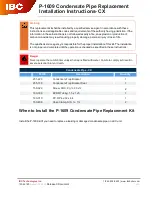
40
XIV Service and Maintenance
The following procedure should be performed on an annual basis:
1) Turn off electrical power and oil supply to the boiler. Unplug burner disconnect.
2) Clean the boiler as follows:
a) Remove vent connector and piping.
b) Remove barometric draft regulator.
c) Remove top jacket panel to gain access to boiler flue collector.
d) Unscrew four wing nuts and remove canopy retaining carriage bolts, lift off the canopy and ceramic fiber sealing
strips.
e) Disconnect the oil lines (if the pump is hard piped), and remove the two 5/16” bolts securing the burner door. Open the
burner swing door.
f) If present, remove the flue baffles. Thoroughly brush boiler flueways from the top and diagonally between casting pin
rows. Be careful when brushing the rear passage not to damage the rear target wall insulation.
g) Vacuum soot and debris from combustion chamber.
h) Check condition of rear target wall insulation, combustion chamber liner, and burner door insulation; replace if
required.
i) Check burner head for signs of deterioration. Clean the head of any deposits.
j) Close burner door, reinstall 5/16” bolts, reconnect fuel oil and electrical lines.
k) Installation of boiler canopy, jacket top panel barometric draft regulator and breeching piping is done in reverse order
of removal. Make sure canopy is sealed tight to the casting; replace ceramic fiber sealing strips as needed. All vent
piping joints must be flue gas leak free and secured with sheet metal screws.
3) Inspect the vent system:
a) Make sure that the vent system is free of obstructions and soot.
b) Make sure that all vent system supports are intact.
c) Inspect joints for signs of condensate or flue gas leakage.
d) Inspect venting components for corrosion or other deterioration. Replace any defective vent system components.
NOTICE
•
Clean the boiler even if there are no significant soot deposits. Failure to remove all sulfur
and ash deposits annually can cause severe corrosion damage.
• When cleaning the rear flue passage, be careful not to push the brush too far beyond the
bottom of the pins. doing so may damage the target wall.
WARNING
The boiler must be connected to an approved chimney in good condition. Serious property
damage could result if the boiler is connected to a dirty or inadequate chimney. The interior
of the chimney flue must be inspected and cleaned before the start of the heating season and
should be inspected periodically throughout the heating season for any obstructions. A clean
and unobstructed chimney flue is necessary to allow noxious fumes that could cause injury or
loss of life to vent safely and will contribute toward maintaining the boiler’s efficiency.
Summary of Contents for TWB Series
Page 2: ......
Page 12: ...10 FIGURE 4 1 FIELD INSTALLATION OF FLUE BAFFLES...
Page 18: ...16 FIGURE 6 4 ALLAIR FROM OUTDOORS USING HORIZONTAL DUCTS INTO BOILER ROOM...
Page 23: ...21 FIGURE 8 3 BOILER BYPASS PIPING FIGURE 8 2 INDIRECT WATER HEATER BOILER SIDE PIPING...
Page 31: ...29 FIGURE 11 0 CONNECTIONS DIAGRAM BOILERS WITH OR LESS TANKLESS HEATER...
Page 51: ...49...
Page 53: ...51...
Page 54: ...52 SERVICE RECORD DATE SERVICE PERFORMED...
Page 55: ...53 Notes...















































